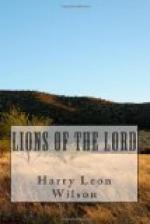From the trappers, scouts, and guides encountered along the road they had received much advice as to eligible locations; and while this was various as to sites recommended, the opinion had been unanimous that the Salt Lake Valley was impossible. It was, they were told, sandy, barren, rainless, destitute of timber and vegetation, infested with hordes of hungry crickets, and roamed over by bands of the most savage Indians. In short, no colony could endure there.
One by one the trappers they met voiced this opinion. There was Bordeaux, the grizzled old Frenchman, clad in ragged buckskin; Moses Harris; “Pegleg” Smith, whose habit of profanity was shocking; Miles Goodyear, fresh from captivity among the Blackfeet; and James Bridger. The latter had discovered Great Salt Lake twenty-five years before, and was especially vehement in his condemnation of the valley. They had halted a day at his “fort,” two adjoining log houses with dirt roofs, surrounded by a high stockade of logs, and built on one of several small islands formed by the branches of Black’s Fork. Here they had found the old trapper amid a score of nondescript human beings, white men, Indian women, and half-breed children.
Bridger had told them very concisely that he would pay them a thousand dollars for the first ear of corn raised in Salt Lake Valley. It is true that Bridger seemed to have become pessimistic in many matters. For one, the West was becoming overcrowded and the price of furs was falling at a rate to alarm the most conservative trapper. He referred feelingly to the good old days when one got ten dollars a pound for prime beaver skins in St. Louis; but “now it’s a skin for a plug of tobacco, and three for a cup of powder, and other fancies in the same proportion.” And so, had his testimony been unsupported, they might have suspected he was underestimating the advantages of the Salt Lake Valley. But, corroborated as he had been by his brother trappers, they began to descend the western slope of the Rockies strong in the opinion that this same Salt Lake Valley was the land that had been chosen for them by the Lord.
They dared not, indeed, go to a fertile land, for there the Gentiles would be tempted to follow them—with the old bloody end. Only in a desert such as these men had described the Salt Lake Valley to be could they hope for peace. From Fort Bridger, then, their route bent to the southwest along the rocky spurs of the Uintah Mountains, whose snow-clad tops gleamed a bluish white in the July sun.
By the middle of July the vanguard of the company began the descent of Echo Canon,—a narrow slit cut straight down a thousand feet into the red sandstone,—the pass which a handful of them was to hold a few years later against a whole army of the hated Gentiles.
The hardest part of their journey was still before them. Their road had now to be made as they went, lying wholly among the mountains. Lofty hills, deep ravines with jagged sides, forbidding canons, all but impassable streams, rock-bound and brush-choked,—up and down, through or over all these obstacles they had now to force a passage, cutting here, digging there; now double-locking the wheels of their wagons to prevent their crashing down some steep incline; now putting five teams to one load to haul it up the rock-strewn side of some water-way.




